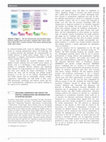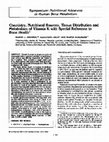Papers by Martin Kohlmeier
Clinical Chemistry and Laboratory Medicine, 1993
We present a new method for analysis of haemoglobin variants in immobilized pH gradients. The iso... more We present a new method for analysis of haemoglobin variants in immobilized pH gradients. The isoelectric fractionation is performed in polyacrylamide gels with copolymerized pH gradients between pH 7.0 and 8.0. The common haemoglobin variants (HbA, HbF, HbS, HbC, HbE and HbA 2 ) are clearly resolved within this pH range. The high resolving power and reproducibility of immobilized pH gradients combined with extremely short separation times make this fractionation technique superior to all electrokinetic procedures used for haemoglobin analysis. At present, isoelectric focusing in immobilized pH gradients is a complementary tool for haemoglobin analysis when classical electrophoretic techniques do not provide sufficient resolution. We hope that in the future this technique will gain the popularity it deserves.

Circulation, 1988
The effects of physical exercise and normalization of serum lipoproteins on stress- induced myoca... more The effects of physical exercise and normalization of serum lipoproteins on stress- induced myocardial ischemia were studied in 18 patients with coronary artery disease, stable angina pectoris, and mild hypercholesterolemia (total serum cholesterol 242 + 32 mg/dl). These patients underwent a combined regimen of low-fat/low-cholesterol diet and regular, supervised physical exercise at high intensity for 12 months. At 1 year serum lipoproteins has been lowered to ideal levels (serum cholesterol 202 ± 31 mg/dl, low-density lipoproteins 130 + 30 mg/dl, very low-density lipoproteins 22 ± 15 mg/dl, serum triglycerides 105 [69 to 304] mg/dl) and physical work capacity was improved by 21% (p < .01). No significant effect was noted on high-density lipoproteins, probably as a result of the low-fat/high-carbohydrate diet. Stress-induced myocardial ischemia, as assessed by thallium-201 scintigraphy, was decreased by 54% (p < .05) despite higher myocardial oxygen consumption. Eighteen patients matched for age and severity of coronary artery disease served as a control group and "usual medical care" was rendered by their private physicians. No significant changes with respect to serum lipoproteins, physical work capacity, maximal rate-pressure product, or stress-induced myocardial ischemia were observed in this group. These data indicate that regular physical exercise at high intensity, lowered body weight, and normalization of serum lipoproteins may alleviate compromised myocardial perfusion during stress.
BMJ nutrition, prevention & health, May 20, 2020
What does this paper add? ► Individuals with high age, excess body fat, dark skin tone or risk-pr... more What does this paper add? ► Individuals with high age, excess body fat, dark skin tone or risk-predicting genetic variants are likely to need extra vitamin D, particularly during the dark months of winter and spring. ► Precision nutrition aims to make nutrition guidance more effective by taking into account key factors that are already known to influence requirements. ► The greater excess of COVID-19 deaths in northern US states appears to support the hypothesis that vitamin D deficiency in African-Americans contributes to their disproportionally higher risk. ► Prevention of vitamin D deficiency at any time of the year must be pursued in earnest, particularly in people most likely to be at risk due to easily identifiable common characteristics.
of food, nutrition and health are identified under each category. Discussion/Conclusion This coll... more of food, nutrition and health are identified under each category. Discussion/Conclusion This collaborative framework is the first step towards the development of a better understanding of the impact of COVID-19 on food, nutrition, and health systems. Limited data availability and disruption in routine data collection as well as other nutrition assessments during the pandemic are challenges that might limit the potential of the proposed framework. Next steps will include formal research and data gap analysis and the identification, as well as utilisation, of other indicators that could be used as proxies of the variables identified.
BMJ nutrition, prevention & health, Jan 2, 2023

Journal of biomedical education, Aug 5, 2015
Purpose. Describe nutrition education at US colleges of osteopathic medicine; determine if it mee... more Purpose. Describe nutrition education at US colleges of osteopathic medicine; determine if it meets recommended levels. Method. We surveyed 30 US colleges of osteopathic medicine (US COM) with a four-year curriculum about the amount and form of required nutrition education during the 2012/13 academic year. The online survey asked about hours of required nutrition across all 4 years and also in what types of courses this instruction occurred. We performed descriptive statistics to analyze the data. Results. Twentysix institutions (87% response rate) completed the survey. Most responding US COM (22/26, 85%) do not meet the recommended minimum 25 hours of nutrition education; 8 (31%) provide less than half as much. Required nutrition instruction is largely confined to preclinical courses, with an average of 15.7 hours. Only 7 of the 26 responding schools report teaching clinical nutrition practice, providing on average 4.1 hours. Conclusions. Most US COM are inadequately preparing osteopathic physicians for the challenges they will face in practice addressing the nutritional concerns of their patients. Doctors of osteopathy cannot be expected to properly treat patients or guide the prevention of cardiovascular disease, obesity, cancer, diabetes, and metabolic syndrome if they are not trained to identify and modify the contributing lifestyle factors.

BMJ nutrition, prevention & health, Jun 1, 2020
Existing micronutrient deficiencies, even if only a single micronutrient, can impair immune funct... more Existing micronutrient deficiencies, even if only a single micronutrient, can impair immune function and increase susceptibility to infectious disease. Certain population groups are more likely to have micronutrient deficiencies, while certain disease pathologies and treatment practices also exacerbate risk, meaning these groups tend to suffer increased morbidity and mortality from infectious diseases. Optimisation of overall nutritional status, including micronutrients, can be effective in reducing incidence of infectious disease. Micronutrient deficiencies are rarely recognised but are prevalent in the UK, as well as much more widely, particularly in high-risk groups susceptible to COVID-19. Practitioners should be aware of this fact and should make it a consideration for the screening process in COVID-19, or when screening may be difficult or impractical, to ensure blanket treatment as per the best practice guidelines. Correction of established micronutrient deficiencies, or in some cases assumed suboptimal status, has the potential to help support immune function and mitigate risk of infection. The effects of and immune response to COVID-19 share common characteristics with more well-characterised severe acute respiratory infections. Correction of micronutrient deficiencies has proven effective in several infectious diseases and has been shown to promote favourable clinical outcomes. Micronutrients appear to play key roles in mediating the inflammatory response and such effects may be enhanced through correction of deficiencies. Many of those at highest risk during the COVID-19 pandemic are also populations at highest risk of micronutrient deficiencies and poorer overall nutrition. Correction of micronutrient deficiencies in established COVID-19 infection may contribute to supporting immune response to infection in those at highest risk. There is a need for further research to establish optimal public health practice and clinical intervention regimens.

The American Journal of Clinical Nutrition, Apr 1, 2000
Background: Computer-based instruction has been introduced at the University of North Carolina at... more Background: Computer-based instruction has been introduced at the University of North Carolina at Chapel Hill to augment its nutrition course for first-year medical students. Seven program modules have been completed; 2 more are planned. Each module explains the biochemistry and physiology of nutrition through interactive lessons, exercises, and a video case study. Objective: The goal of this study was to evaluate the instructional efficacy and acceptability of the nutrition and cancer module when used by first-year medical students. Design: The module was used by 163 first-year medical students at the university's medical school as an obligatory component of the nutrition course. Before and after using the module, students were asked to answer multiple-choice questions concerning their knowledge and attitudes; each question had 5 possible answers. Results: On average, students spent Ϸ3 h studying the lessons. The percentage of correct responses to 20 knowledge questions increased from 22% before the module was used to 86% immediately after its use. When a randomly selected subsample of 25% of the students took the same test 3 mo later, they answered 62% of the questions correctly. The increase in the percentage of students who felt prepared to provide advice regarding nutrition's role in cancer prevention (from 5.7% to 66.9%) suggested a successful subjective learning experience. Neither the students' initial level of interest in cancer nutrition nor their acceptance of computerbased instruction was related to learning outcome. The tested module is a useful and effective aid for teaching nutritional principles of cancer prevention. The evaluation strategy helped identify areas for instructional improvement.

BMJ nutrition, prevention & health, Jul 14, 2023
Nutrition science has been criticised for its methodology, apparently contradictory findings and ... more Nutrition science has been criticised for its methodology, apparently contradictory findings and generating controversy rather than consensus. However, while certain critiques of the field are valid and informative for developing a more cogent science, there are also unique considerations for the study of diet and nutrition that are either overlooked or omitted in these discourses. The ongoing critical discourse on the utility of nutrition sciences occurs at a time when the burden of noncommunicable cardiometabolic disease continues to rise in the population. Nutrition science, along with other disciplinary fields, is tasked with producing a translational evidence-base fit for the purpose of improving population and individual health and reducing disease risk. Thus, an exploration of the unique methodological and epistemic considerations for nutrition research is important for nutrition researchers, students and practitioners, to further develop an improved scientific discipline for nutrition. This paper will expand on some of the challenges facing nutrition research, discussing methodological facets of nutritional epidemiology, randomised controlled trials and meta-analysis, and how these considerations may be applied to improve research methodology. A pragmatic research paradigm for nutrition science is also proposed, which places methodology at its centre, allowing for questions over both how we obtain knowledge and research design as the method to produce that knowledge to be connected, providing the field of nutrition research with a framework within which to capture the full complexity of nutrition and diet.

Carolina Digital Repository (University of North Carolina at Chapel Hill), 2006
The primary mission of the Nutrition in Medicine (NIM) project is to provide tools to facilitate ... more The primary mission of the Nutrition in Medicine (NIM) project is to provide tools to facilitate the nutrition training of undergraduate medical students. NIM has developed and distributed a CD-ROM-based nutrition curriculum to medical schools since 1995. However, the medical school environment is changing rapidly; there is pressure to do more in less time, and many schools are emphasizing independent and integrated learning. The need for a nutrition curriculum that is more flexible and more accessible has driven the evolution of the NIM curriculum from CD-ROM-based delivery into a more modular curriculum with Web delivery. Such changes facilitate access and eliminate the need for installation of CD-ROMs and the associated technical support issues. In addition, the instructional units are smaller and more modular. Eventually, the authoring system will allow instructors to put together a course to meet their specific instructional needs. Our future plans also include custom-tailoring that will allow students to opt out of learning material on the basis of pretest scores if they are already proficient in the content. In this update, we provide a detailed description of the new system and the rationale for the modifications we made. Furthermore, we describe how each change addresses barriers to nutrition education as identified from our surveys and others and from direct user feedback. These innovative strategies should allow a better fit of NIM within diverse medical school environments and help to promote incorporation of the curriculum into more medical schools.
BMJ nutrition, prevention & health, Jul 17, 2018
Current developments in nutrition, Jun 1, 2020
BMJ Nutrition, Prevention & Health

Oral presentations
be achieved through policy action by making changes in legislation, by ensuring organisational cu... more be achieved through policy action by making changes in legislation, by ensuring organisational culture and leadership, and by creating networks and champions for environmentally sustainable practices in health system settings. There is also an opportunity to integrate environmental sustainability in health systems teaching and research. Lessons from fighting the Covid-19 pandemic could be applied towards reducing food and health system impacts on climate, such as i) developing a clear understanding of the problem, of potentially effective solutions and identifying those interests are being prioritised, ii) start tackling the problem from areas making the largest contributions or being affected the most, and iii) knowing that shifting people's behaviour is at the core of any solution. Transformed food and health systems must be contextually relevant, resilient, regenerative, empowering, and with health at their centre. Bold government, community, and business actions that promote interdisciplinarity, collaboration and capacity building are key aspects to be considered.

Journal of Nutrition, Apr 1, 1996
Vitamin K occurs in nature as a serÃ-esof compounds with a common 2-methyl-l ,4 naphthoquinone nu... more Vitamin K occurs in nature as a serÃ-esof compounds with a common 2-methyl-l ,4 naphthoquinone nucleus and differing isoprenoid side chains at the 3 position. They comprise a single major plant form, phylloquinone with a phytyl side chain and a fam ily of bacterially synthesized menaquinones (MKs) with multiprenyl side chains. The major dietary source to humans is phylloqui none for which the chief food contributors are green, leafy vegetables followed by certain vegetable oils (soybean, rapeseed and olive oils). Recent analyses by high pressure liquid chromatography are now providing a wide-ranging database of phylloquinone in foods. Menaquinones are found in moderate concentrations in only a few foods such as cheeses (MK-8 and MK-9). A wider spectrum of MKs is synthesized by the gut microflora, and their intestinal absorption probably accounts for most of the hepatic stores, particularly those with very long side chains (MKs-10-13) synthe sized by members of the genus Bacteroides. The site of absorption of floral MKs is not known, but reasonable concentrations are found in the terminal ileum where bile salt-mediated absorption is possible. Both phylloquinone and menaquinones are bioactive in hepatic gamma-carboxylation but long-chain MKs are less well absorbed. Liver stores of vitamin K are relatively small and predominantly MKs-7-13. The he patic reserves of phylloquinone (10% of the total) are labile and turn over at a faster rate than menaquinones. Trabecular and cortical bone appear to contain sub stantial concentrations of both phylloquinone and menaquinones. A majority (~60-70%) of the daily di etary intake of phylloquinone is lost to the body by excretion, which emphasizes the need for a continuous dietary supply to maintain tissue reserves. J. Nutr.










Uploads
Papers by Martin Kohlmeier